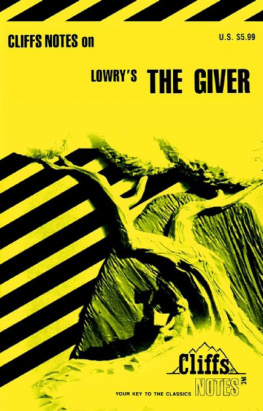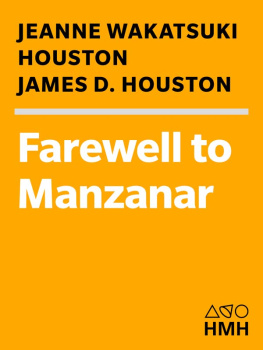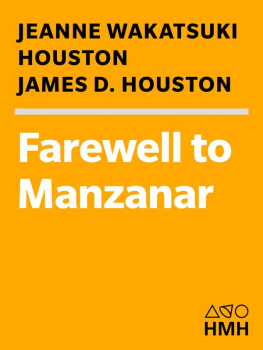Copyright 1993 Houghton Mifflin Harcourt Publishing Company
All rights reserved.
www.hmhco.com
cliffsnotes.com
For information about permission to reproduce selections from this book, write to or to Permissions, Houghton Mifflin Harcourt Publishing Company, 3 Park Avenue, 19th Floor, New York, New York 10016.
The publisher and the author make no representations or warranties with respect to the accuracy or completeness of the contents of this work and specifically disclaim all warranties, including without limitation warranties of fitness for a particular purpose. No warranty may be created or extended by sales or promotional materials. The advice and strategies contained herein may not be suitable for every situation. This work is sold with the understanding that the publisher is not engaged in rendering legal, accounting, or other professional services. If professional assistance is required, the services of a competent professional person should be sought. Neither the publisher nor the author shall be liable for damages arising herefrom. The fact that an organization or website is referred to in this work as a citation and/or a potential source of further information does not mean that the author or the publisher endorses the information the organization or website may provide or recommendations it may make. Further, readers should be aware that Internet websites listed in this work may have changed or disappeared between when this work was written and when it is read.
Trademarks: CliffsNotes, the CliffsNotes logo, Cliffs, cliffsnotes.com, and all related trademarks, logos, and trade dress are trademarks or registered trademarks of Houghton Mifflin Harcourt Publishing Company. All other trademarks are the property of their respective owners. Houghton Mifflin Harcourt is not associated with any product or vendor mentioned in this book.
eISBN 978-0-544-18147-2
v1.1116
Life and Background of the Authors
Introduction
In a straightforward, nonfiction memoir, Jeanne Wakatsuki Houston and her husband, James D. Houston, recount the Wakatsuki familys internment at Manzanar War Relocation Center, one of ten concentration camps devised by President Franklin Roosevelts Executive Order 9066 following the Japanese surprise bombing of Pearl Harbor on December 7, 1941. To some readers, the book is an introduction to a thorny era in their countrys history, a time of deprivation of rights without due process for 120,000 Japanese Americans. Jeannes reliving of intimate, painful details provides what no historical account cana view of life for 30,000 Asian Americans in a stark, concentration-camp atmosphere on the rim of Californias Mojave Desert. The factual narrative follows her through three decades of silent denial to adulthood, when she is, at last, able to reveal the misery, the degradation of her family and race, and exorcise Manzanar with an act of public enlightenment.
Jeannes Early Years
For Jeanne Toyo Wakatsuki, childhood security flowed naturally from the loving, accepting kin who made up her household. Born in Inglewood, California, on September 26, 1934, to native Japanese parents, Ko and Riku Sugai Wakatsuki, Jeanne, the youngest of four boys and six girls, moved with her family to Ocean Park in 1936. In an interview, she recalled the pier as a magical place, my nursery school, the amusement attendants my sitters. She grew up admiring the strutting self-confidence of her father, a farmer and commercial fisherman, and her pragmatic, low-key mother, who worked in a Long Beach fish cannery. Prophetic of Jeannes individualism, the Wakatsukis had met in Spokane, Washington, eloped, and married for love, defying an arranged engagement between Riku and a farmer.
Jeannes female role models, evolved from two previous generations, helped develop a sense of self, a concept deeply rooted in the Japanese separation of male and female roles. Her maternal grandmother, although restricted by blindness and speaking no English, served as a link with Japan, as demonstrated by old country treasures she handled delicatelythe lacquered tables and fragile blue and white porcelain tea service, reminiscent of a genteel culture incompatible with her new home in the United States. Jeannes mother understood and accepted her place in a patriarchal marriage. With less time to devote to the niceties of serving tea than her aged mother enjoyed, she resigned herself to the thankless jobs of scrubbing floors, washing clothes, cooking, waiting on Ko, and tending her ten children. When Jeanne expressed terror that her Oka-San might drop dead from overwork, Riku soothed, Im not a washerwoman. This is just a chore, something I must do because Im a woman, but foremost, Im your mother.
Jeanne was seven years old when the bombing of Pearl Harbor plunged the U.S. into World War II. The Wakatsukis, their lives interrupted during a post-Depression upsurge in family finances, were among the first to be questioned and detained. FBI agents confronted Ko with photos of barrels of fish bait and accused him of supplying oil to enemy submarines. Although the charge was unfounded in a court of law, he spent nine months apart from his clan in a Bismarck, North Dakota, prison. During his imprisonment, in April 1942 his wife and son Woody assumed responsibility for resettling the family in Block 16 of Manzanar, an austere, barbed-wire enclosed, mile-square internment camp near Lone Pine, California, 4,000 feet above sea level in the shadow of Mount Whitney.
From her early memories of Mama, Papa, Woody, brother Kiyo, sister May, sister-in-law Chizu, and others came the book Farewell to Manzanar (1973), a retelling of Jeannes girlhood traumas and dreams in the milieu of an artificial Japanese-American city, the largest metropolis (10,000 Japanese Americans) between Reno and Los Angeles. She recalls the experience as a yellow blur of stinging whirlwinds and fierce duststorms that pricked the skin like needles and coated everything, including our lips and eyelashes, with thick ochre powder.
Amid rows of dreary barracks, functional mess halls and latrines, and intimidating gatehouses and fences, she and her peers lived out a semblance of normality, singing in the glee club, acting in school plays, enjoying the taste of her first snowflake, and wondering how the inflamed white populace would accept them when Japanese Americans were finally released from custody. She recalled later a major source of comfort: she discovered an abandoned box of books in a firebreak and escaped camp misery through Hans Christian Andersens Fairy Tales, Nancy Drew mysteries, James Fenimore Coopers Leatherstocking series, and Emily Bronts Wuthering Heights.
In September 1942, Ko, an embittered ex-con, was transferred to Manzanar from a North Dakota prison. His reclusive habits and escapism through home-distilled rice wine ignited explosive domestic violencethreats, shoving, and screaming. Jeanne and her youngest brother hid as far under the covers as possible, but the limited quarters afforded no privacy or respite from daily turmoil. To distance herself from home, Jeanne stayed outdoors, twirled her baton, and studied traditional Japanese dancing. For a time, she flirted with Catholicism by losing herself in the melodrama of saints and martyrs lives and the dogma of catechism. Kos refusal to allow her to be converted and baptized, however, narrowed her outlets to school and dance.
The close-knit Wakatsukis began breaking up as older siblings moved to job opportunities on nearby farms and through military service. In November 1944, Woody entered active service and was shipped to Germany. That winter, occupancy at Manzanar dropped to twenty percent. Ko, fearful of West Coast anti-Japanese hysteria, resisted departure until October 1945, when his name came up for forced expulsion. His crazy, drunken departure in a new car forms the ebullient conclusion to Jeannes memoir.
Next page











